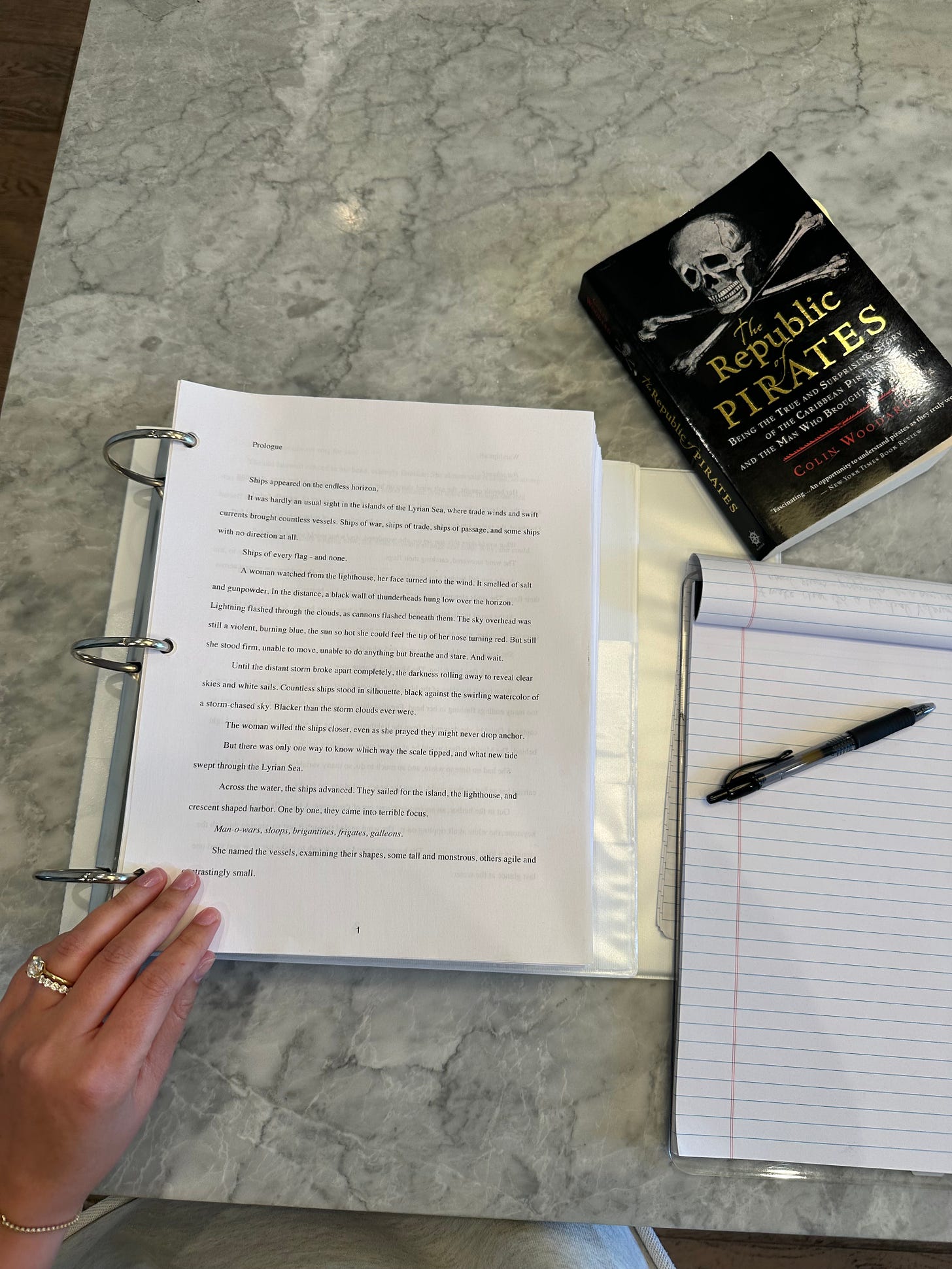If you’ve been following along on my other social media platforms (Threads, Instagram, TikTok), you’ll know that TEMPEST is officially in edits. Meaning I’ve finished the first draft of the novel, and I’m now in the stage of writing a book that means I have bedrock beneath me.
*If you want more timely updates on my writing process, make sure to follow me on my other platforms, where I post videos and photos almost every day.
So what does the edit stage look like?
I must caution it is a little different for every author - we all have our own process - but there are shared steps for many of us in the traditional publishing space. Namely, once we finish a draft to our liking, we pass it on to our developmental editors and then eventually copy editors. They are integral in transforming a manuscript into a book.
Some authors will take their drafts to a round of beta readers before going to their editors. That isn’t a step I utilize in my process, largely because I don’t write fast enough for it. My drafts Tokyo Drift into my editor’s inbox on the day of deadline, if not after. In the case of TEMPEST, which ended up being much bigger than I expected, it was way after.
Now that TEMPEST is with my editors (I’m working with both my US and UK editors on this one), here’s how the process will hopefully unfold based on my previous experience - and my preference.
I sent my first draft (the unedited, finished manuscript) in to my editors.
My editors then take what time they need to read the first draft, digest it, and write up an edit letter. I prefer getting my notes in a full overview that I can take in as one big piece, versus notes imbedded in the draft, which some other authors prefer. The edit letter is a scary thing to open, and I still have to hype myself up to read them. They’re usually a macro and micro view of the story - what worked, what didn’t, what suggestions and questions the editors might have, along with any other thoughts they have on the work. My agent also reads at this point too.
I execute the edit letter. No, I don’t cut its head off (though sometimes I wish I could). Instead I print it out, highlight and annotate the letter (I’ve had letters as long as 10 pages), and keep it in hand as I dive back into the draft looking to make her better. Usually my editors have great notes and ideas, but no one agrees with 100 percent of an edit letter. I’m not exception. The skill is in figuring out where the bumps are, and smoothing them out as much as possible for a reader. By the time I finish this round, I will be sending the second draft to my editors.
This is where things can start to differ book to book - I usually have one or two more rounds with my development editors, meaning I end up with a third or fourth draft. These rounds are smaller and focused on fixing smaller issues in the work that slipped through on the previous rounds.
A really exciting part of the process is going to copy edits - when the third/fourth draft goes to copy editors. They specialize in the nitty gritty of spelling and grammar, not to mention they are wizards for continuity errors and repetition. At this point, it’s also great to get new eyes on the manuscript. I’ve had a lot of things caught in copy edits before that slipped us all in previous rounds, and I’m immensely grateful. But I’ll still never learn how to use a semi-colon correctly. Copy edits is also exciting because a manuscript is considered delivered and accepted at this stage. Meaning, for most contracts in traditional publishing, you get paid another installment of your advance! Hooray!!
Following a round of copy edits, now you have a fifth or sixth draft of your manuscript. And your eyes are falling out. Lucky you, now we get to look at proofs (or pass pages). This is when the manuscript is typeset - or laid out as it will be in the printed book. You’re looking at the manuscript as it will look on the shelf - these used to be printed out but now usually come as PDFs. At this point, I am mostly looking for typos and any egregious slips, but I’m also editing for the eye*.
After proofs, it’s time to go to print. And once that day passes, the book is LOCKED. Meaning you can no longer touch it, she is out of your hands, and now all you can do is go slightly insane until pub day. At this point, I refuse to look anywhere near the draft in case I find something wrong or want to change something. Because I no longer can! Timelines vary - I’ve had books locked a year and a half out, to less than 4 months. It all depends on your publisher, and shorter timelines are more common with books in a series.
That’s the basic steps through editing - stay tuned for my next letter where I go over exactly how I approach this process, and what I do to make my manuscript the best book it can be.
Summer Updates
It’s officially summer in Los Angeles, and I hope you’re enjoying nice weather and long days wherever you are! Here’s a little info on where I’ll be and what I’m hopefully doing over the next few months.
Events - stay tuned for more info when I can officially announce, but I will be chairing 2 local book events in LA/Orange County area, and visiting THREE countries in Europe this fall for festivals and touring! I can’t wait to let you know where I’m going.
Indy - Thanks so much for all the kind thoughts and well wishes as my dog Indy went through another surgery. It’s her first abdominal emergency surgery in four years, and we are very grateful to have access to her excellent vets at VCA West LA. As many of you know, Indy has had multiple surgeries over the years, first due to a freak intestinal episode, and then to break up scar tissue forming after her surgeries. This was a similar episode, and she is recovering beautifully.
Goals for the summer
I’m setting one work goal, and that is to finish the second draft of TEMPEST, if not be stuck into Draft 3. I will also most likely be working on a proposal for a new book, but I have to get my one-sheets** in order before I can brainstorm directions with my agent.
Read three books. GASP. Only three? Victoria, for shame. YES FOR SHAME. I have been a ridiculously slow reader since 2020, and I think my brain is a little broken. I also find it hard to read when I’m drafting/editing, and that’s almost all the time - it’s especially bad now because TEMPEST is 1000+ pages long. But I will try!!! I’m setting my bar very low so hopefully I sail over it.
And that’s it for me for this installment! Never fear, I plan to get another newsletter out soon with more info on editing AND events in the near future.
I would be remiss if I did not add that, at present, the President of the United States is sending the National Guard and US Marines into my city, against the will of our state government and our local law enforcement. It is an egregious abuse of power, designed to instigate violence and justify a violent response. All because the city of Los Angeles is a city of immigrants, and we will not betray the core values of our community. I stand in solidarity with my friends and neighbors. We will not turn on each other, and destroy a community built on hard work and hope. I am particularly inspired by the brave educators of the LAUSD protecting their students, and their futures in America.
Stay safe, stay curious, I love you all.
Victoria
*I plan on doing a video/post on what I mean by “editing for the eye.”
**I just posted a TikTok explaining one-sheets but I’m happy to do the same in a future newsletter!







As someone who is hoping to start querying this autumn, I'd be really interested in hearing more about book proposals/one sheets. I've heard you mention them a couple times now and *think* I understand, but would love to know more. :)
Thank you for digging into the editing process! I’ve been so curious about how that phase works. Cannot wait to read Tempest!